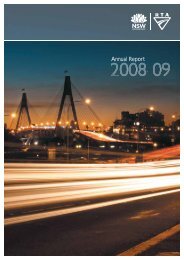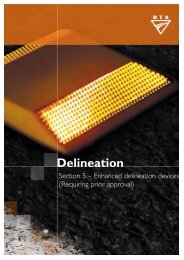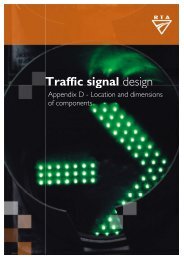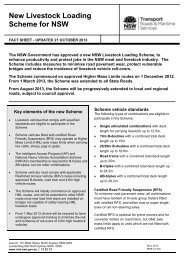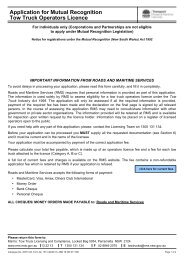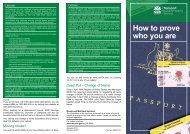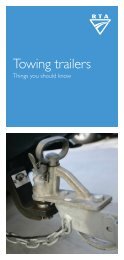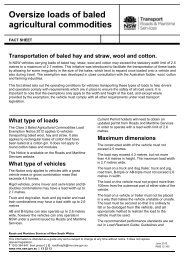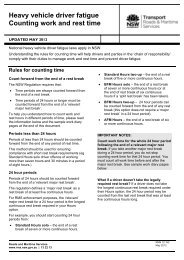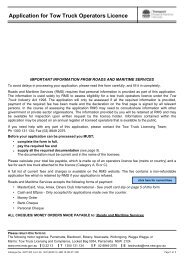Traffic Signal Design - Section 11 Detectors - RTA
Traffic Signal Design - Section 11 Detectors - RTA
Traffic Signal Design - Section 11 Detectors - RTA
Create successful ePaper yourself
Turn your PDF publications into a flip-book with our unique Google optimized e-Paper software.
<strong>Traffic</strong> <strong>Signal</strong> <strong>Design</strong> – <strong>Section</strong> <strong>11</strong> <strong>Detectors</strong><br />
In general, the numbers are allocated in ascending order based strictly on the alphanumeric<br />
sequence of the detector labels. If there is more than one detector with the same label, the<br />
detector numbers are ordered according to the lane label (i.e. L, CL, C, CR, R) before<br />
progressing to the next detector label. For <strong>11</strong> m detectors, the departure section is<br />
numbered before the approach section.<br />
The numbering of special counting detectors comes after normal vehicle detectors. As these<br />
detectors must be visible to SCATS, they must be numbered somewhere in the range 1 to 24.<br />
If there are 24 vehicle detectors in use for traffic signal control, then counting detectors<br />
cannot be used unless minor vehicle detectors are moved to detector numbers greater than<br />
24 or the detectors are paralleled, e.g. the L, C and R detectors are placed on the same input.<br />
If there is an emergency service phase, the last detector number after any push button<br />
detectors should be allocated to call this phase. If a second (separate) detector is used to call<br />
this phase or to call a second phase, then the next detector number should be allocated to the<br />
second detector. See drawing No. TS-TN-022 for further details.<br />
In SCATS, only detectors 1 to 24 are available for strategic purposes as vehicle detectors.<br />
Where there are more than 24 vehicle detectors, those detectors that are required for<br />
strategic purposes are to be numbered in the range 1 to 24 regardless of the alphanumeric<br />
detector labelling.<br />
Where sister linking is required, detector number 8 is to be allocated to the repeat detector<br />
from the linked site.<br />
Push-button detectors generally follow vehicle detectors. There is a maximum of 8 push<br />
button detector inputs in SCATS and these can be numbered up to, and including, number 32.<br />
For sites using the post mounted controller, detectors 1 to 12 are for vehicle detectors and<br />
the push button detectors follow the vehicle detectors, with a maximum of 8 push button<br />
detector inputs in SCATS, and these can be numbered up to, and including, detector number<br />
20.<br />
The numbering for vehicle detectors is placed within the detector symbol on the plan. Pushbutton<br />
detector numbers are added in brackets following each push-button detector label, e.g.<br />
A(12), A-B(13) and C(14). Note that push-buttons with the same detector label are to have<br />
the same detector number, unless the push buttons are required to be split, to suit the red<br />
arrow protection for a long pedestrian crossing.<br />
Detector numbers are not usually allocated to future detectors. It should only be considered<br />
in the case where the addition of a future detector does not warrant a change in the<br />
controller's personality, e.g. the addition of a lane due to imminent road widening or sealing.<br />
The reserved detector number should be shown on the design layout together with a suitable<br />
note requesting provision in the cabling and detector sensors for the reserved detector (see<br />
also <strong>Section</strong> 13 Provision for Future Facilities ).<br />
<strong>11</strong>.7 DETECTOR LOGIC<br />
<strong>11</strong>.7.1 General<br />
Vehicles can be detected during two parts of the traffic signal cycle. <strong>Traffic</strong> waiting for a green<br />
signal registers an initial demand that it requires right-of-way (i.e. calls a phase) and traffic<br />
already given the right-of-way via a green signal registers its continuing requirement for right-<br />
Version 1.3 <strong>11</strong>-9<br />
UNCONTROLLED WHEN PRINTED



